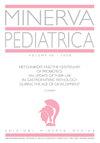埃勒斯-丹洛斯综合征患儿舌系带缺失:40例病例的回顾性研究和20年争论的文献综述。
IF 2.6
4区 医学
Q2 Medicine
引用次数: 5
摘要
背景hlers-Danlos综合征是结缔组织疾病的一部分,其特征是皮肤过度伸展、关节活动过度、容易瘀伤和其他严重表现,如癫痫、肺气肿、动脉破裂和肠穿孔。2017年发布了一种新的分类法,指出了每种EDS的主要和次要标准。过去几年的进一步报道试图确定是否应将舌系带缺失纳入EDS诊断的次要标准,但仍未达成共识。本研究的目的是评估舌系带缺失的临床相关性,评估其在EDS儿科患者队列中的患病率,并将其与对照组进行比较。方法在意大利帕维亚马泰奥警察诊所儿科对埃勒斯-丹洛斯综合征患者进行观察。每位患者都接受了口腔临床检查,并在转诊至我科的患者中选择对照组。结果40例患者中有3例出现舌系带缺失,其中3例出现系带发育不全。在我们的人群中,舌系带缺失或发育不全的患病率为90%,而只有3/170的对照组(1.8%)出现舌系带缺失。总体而言,在我们的人群中,舌系带缺失显示出90%的敏感性和98.2%的特异性。结论与其他作者一致,我们认为舌系带缺失应纳入埃勒斯-丹洛斯综合征的次要诊断标准。本文章由计算机程序翻译,如有差异,请以英文原文为准。
Absence of lingual frenulum in children with Ehlers-Danlos Syndrome: a retrospective study of forty cases and literature review of a twenty years long debate.
BACKGROUND
Ehlers-Danlos syndrome is part of connective tissue disorders and is characterized by skin hyperextensibility, joint hypermobility, easy bruising and other severe manifestations such as epilepsy, pneumothorax, arterial rupture and bowel perforation. In 2017 a new classification was published, indicating major and minor criteria for each form of EDS. Further reports in the past years tried to determine whether or not the absence of lingual frenulum should be included in minor criteria for the diagnosis of EDS, but a consensus has still not been reached. The aim of this study is to assess the clinical relevance of lingual frenulum absence, evaluating its prevalence in a cohort of EDS pediatric patients and comparing it to a group of controls.
METHODS
Patients with Ehlers-Danlos syndrome were observed at our Department of Pediatrics of Policlinico S.Matteo in Pavia, Italy. Each patient underwent clinical examination of the oral cavity, and controls were chosen among patients referred to our Department.
RESULTS
Thirty-three over 40 patients showed absence of lingual frenulum and 3 of them showed frenulum hypoplasia. Absence or hypoplasia of lingual frenulum showed a prevalence of 90% in our population, whereas only 3/170 controls (1.8%), had lingual frenulum absence. Overall, absence of the lingual frenulum showed a sensibility of 90% and a specificity of 98.2% in our population.
CONCLUSIONS
In agreement with other authors, we believe that the absence of lingual frenulum should be included in the minor diagnostic criteria for Ehlers-Danlos Syndrome.
求助全文
通过发布文献求助,成功后即可免费获取论文全文。
去求助
来源期刊

Minerva pediatrica
PEDIATRICS-
CiteScore
2.70
自引率
3.80%
发文量
1
审稿时长
>12 weeks
期刊介绍:
Minerva Pediatrica publishes scientific papers on pediatrics, neonatology, adolescent medicine, child and adolescent psychiatry and pediatric surgery. Manuscripts may be submitted in the form of editorials, original articles, review articles, special articles, letters to the Editor and guidelines. The journal aims to provide its readers with papers of the highest quality and impact through a process of careful peer review and editorial work.
 求助内容:
求助内容: 应助结果提醒方式:
应助结果提醒方式:


